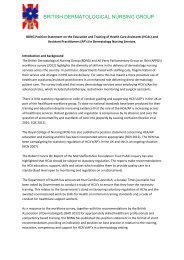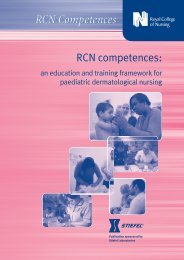Improving outcomes for people with skin tumours including melanoma
Improving outcomes for people with skin tumours including melanoma
Improving outcomes for people with skin tumours including melanoma
Create successful ePaper yourself
Turn your PDF publications into a flip-book with our unique Google optimized e-Paper software.
As set out in the section on ‘Arrangements <strong>for</strong> <strong>skin</strong> cancer teams’,<br />
patients <strong>with</strong> <strong>skin</strong> cancer occurring on the head and neck may be<br />
managed locally by head and neck cancer specialist MDTs and<br />
centres. These patients may be reviewed as appropriate by the<br />
SSMDT. There should be clear management arrangements and links<br />
between the SSMDT and other cancer site-specific MDTs.<br />
<strong>Improving</strong> Outcomes <strong>for</strong><br />
People <strong>with</strong> Skin Tumours<br />
<strong>including</strong> Melanoma<br />
Organisation of <strong>skin</strong><br />
cancer services<br />
Core membership of the SSMDT<br />
The SSMDT should include the following:<br />
• Dermatologists. There should be at least two dermatologists, one<br />
of whom should have a major interest in <strong>skin</strong> cancer and/or<br />
<strong>skin</strong> cancer surgery; another should ideally have a major interest<br />
in cutaneous lymphoma. There should be a designated lead and<br />
ideally a deputy lead, and any dermatologist involved in <strong>skin</strong><br />
cancer care should attend the MDT meeting.<br />
• Surgeons. At least two surgeons should have a designated interest<br />
in <strong>skin</strong> cancer surgery and per<strong>for</strong>m at least 15 block dissections<br />
each (groin or axilla) per year. Radical or conservative neck<br />
dissections (<strong>for</strong> cancer of the head and neck) should only be done<br />
by specialists regularly undertaking this procedure or who are<br />
members of the head and neck cancer MDT. A combination could<br />
include plastic surgeons, surgical oncologists, oral and<br />
maxillofacial surgeons, oculoplastic surgeons and ENT surgeons. It<br />
may be appropriate locally to include as extended team members<br />
oculoplastic surgeons and reconstructive hand surgeons.<br />
Oculoplastic surgeons have a specific and important role in the<br />
management of <strong>skin</strong> cancers arising around the eye.<br />
3<br />
• Skin cancer CNSs (as defined by the Manual of Cancer<br />
Services 27 ). Patient advocacy and provision of in<strong>for</strong>mation and<br />
support <strong>for</strong> patients and carers are crucial aspects of this role.<br />
The CNS will play a key role in communication between the<br />
patients and the different specialties involved in management<br />
and must have a high level of communication skills. She or he<br />
should be able to provide practical support such as advice<br />
postoperatively. The CNS will also have an important role in the<br />
identification of patients’ psychosocial needs and will advise on<br />
appropriate referral. The CNS may, if suitably trained, carry out a<br />
range of related service activities such as minor surgery, <strong>skin</strong><br />
cancer surveillance and follow-up clinics in parallel <strong>with</strong> an<br />
appropriately trained doctor.<br />
27 Department of Health (2004) Manual of Cancer Services. Available from: www.dh.gov.uk<br />
Guidance on cancer services: <strong>skin</strong> <strong>tumours</strong> <strong>including</strong> <strong>melanoma</strong><br />
59















